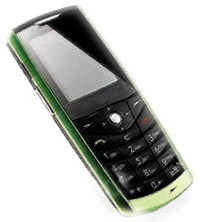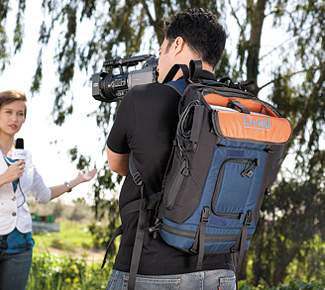NBC Says 'Just Phone It In'
NEW YORK
NBC News has deployed a new ENG-to-studio link system that has the potential to reduce or supplement the network's dependence on conventional microwave and satellite vans for coverage of breaking news stories, and at the same time allow reporters to get closer to the action.
NBC has been experimenting with the LiveU system for about a year. It bridges the bandwidth gap needed for live video transmission by "bonding" together multiple cell phone circuits, and according to network personnel, could substantially reduce the cost of newsgathering.

"NBC News is always considering new technologies, particularly ones that can improve on our production capabilities, while decreasing expenditures, and discovered an Israeli technology called LiveU that can provide a video interconnection without the need for a satellite," said Lauren Kapp, NBC's senior director of news communication. "We were able to provide coverage of the recent earthquake damage in Italy with just a small backpack unit. We also used it for covering the Obama train ride. It worked all over the Amtrak route."
While the LiveU system doesn't guarantee a fixed or minimum amount of transmission bandwidth, users at the network report that they have been generally obtaining between 1.2 Mbps and 1.5 Mbps, with sometimes a dip below this. Such bitstreams won't bring back HD images, but there is sufficient bandwidth for delivery of breaking stories to the newsroom without the delay involved in dispatching an ENG truck and having its operator line up microwave dishes or boresight a satellite connection. Another plus is that there are no spectrum management issues.
FORGET FREQUENCY COORDINATION
"When we're deciding what the best technology to send for the application, we know this needs no frequency coordination," said Stacy Brady, senior vice president of network news field operations and media traffic control. "This is something that we'd normally have to do, and is a big plus in some situations."
The LiveU system is packaged to fit within a backpack and weighs between 10 and 15 pounds. It is designed to work with any cell phone service available and is very simple to operate.
"The technology combines six cell phone aircards," said Jeff Coneys, NBC's director of media traffic control. "The operator just points to an IP address on a server we have here at 30 Rock. We then use a scan converter to get the signal onto a video router to get it to air. The company [LiveU] is working on an SDI card to allow us to go directly to air."
NBC found out about LiveU system last year when Brady and Dan Miller, NBC's manager of information exchange technology, visited Tel Aviv and heard about it from a former network employee there. "We looked at it and it was very promising," said Miller.
However, as the manufacturer was not broadcast-oriented, it took a while to shape the technology into a useful platform for shipping news content from the field to the studio.
"We've been working with them for the past year," said Brady. "They're not really a broadcast company and we had to explain the application and how we'd use it."
PROVIDES 'UP AND CLOSE' COVERAGE

The LiveU technology allows a camera person to go live anywhere that a cell phone works. The LiveU backpack was designed for portability and is very much at home in a "roving reporter" application, as there is no umbilical cable or requirement to keep a conventional portable microwave transmitter lined up or within range with its receiver. This became an advantage during the network's coverage of the April earthquake in Italy. Even though roads and streets were impassible for vehicular traffic, enough of the region's cell phone infrastructure remained operational to permit LiveU-equipped reporters to transmit video from the devastated region.
Brady said that the network is so pleased with the results that they have now purchased seven systems and obtained exclusive rights to roll out the video-over-cell phone technology worldwide.
While LiveU may not totally replace conventional ENG backhaul methodologies just yet, it has already made a change in at least part of NBC's news operation.
"We've gotten rid of our satellite desk and merged all operations into a single desk," said Kapp. "We think this is a better and more efficient way to coordinate newsgathering activities."
As with any new technology there are some downsides, but these don't appear to be insurmountable.
"There are always going to be some bumps in the road," said Brady. "We're learning more and more about the technology every day. While it's not rock solid, it is very dependable. However there is a significant delay and we're trying to shorten up that time. But all in all, the technology is working really great."
The delay that Brady spoke of is long enough to be problematic in some applications. The system has three operational modes that allow users to trade off picture quality vs. delivery latency, with the best video quality taking about a minute to make it through the system. An intermediate mode provides acceptable pictures that take only 10 to 20 seconds to arrive, while a "Q & A" setting cuts latency down to about five seconds, (but with considerably lowered image quality).
And Miller admits that this delay factor does take some getting used to by talent and operators who are accustomed to more or less instantaneous transmission from the field.
"There's always a 'cultural experience' in dealing with any new equipment," he said. "Dealing with the latency is the most challenging thing for our people right now. Right now it's just one step at a time."
Network personnel also pointed out that unlike satellite newsgathering, which by nature is multipoint, the LiveU system is strictly point-to-point. Without a secondary communications path, this would preclude direct use by more than one newsroom at a time, and could be a non-starter in some incidents.
ENG VANS STILL HAVE A PLACE
Another factor that's probably destined to keep at least some conventional ENG linkage capability at the ready is that while cell phone service has matured to the point where it's very good, very reliable and nearly ubiquitous, it can go down for the count once in a while. Memories of the totally swamped cell and land lines that resulted after 9/11 are still fresh in the minds of anyone involved in newsgathering.
However, convenience and portability notwithstanding, simple economics could cause many ENG vehicles to be reconciled to the parking garage for long spells. NBC personnel were reluctant to state how much money LiveU might save in a year's time, but Brady did offer a suggestion.
"Each ENG truck has a $3,000 daily price tag," she said. "That gives you some idea of the savings."
This LiveU budget-stretching factor was put to good use in April while the network was covering a breaking story involving multiple execution-style slayings in upstate New York. In this situation, the system was used to supplement conventional ENG gear.
"We had a live truck up at Binghamton to cover the shooting," said Coneys. "When the press conferences started, we decided it made more sense to send in a LiveU unit rather than a second truck."
Get the TV Tech Newsletter
The professional video industry's #1 source for news, trends and product and tech information. Sign up below.
James E. O’Neal has more than 50 years of experience in the broadcast arena, serving for nearly 37 years as a television broadcast engineer and, following his retirement from that field in 2005, moving into journalism as technology editor for TV Technology for almost the next decade. He continues to provide content for this publication, as well as sister publication Radio World, and others. He authored the chapter on HF shortwave radio for the 11th Edition of the NAB Engineering Handbook, and serves as editor-in-chief of the IEEE’s Broadcast Technology publication, and as associate editor of the SMPTE Motion Imaging Journal. He is a SMPTE Life Fellow, and a Life Member of the IEEE and the SBE.

